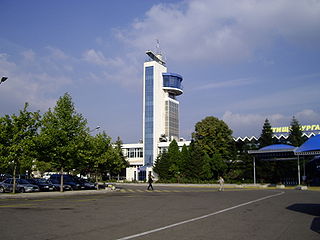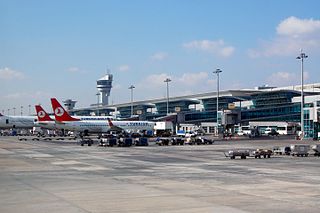
Alas Chiricanas Flight 00901, registered HP-1202AC, was an Embraer EMB 110 Bandeirante aircraft flying en route from Colón city to Panama City which exploded shortly after departing Enrique Adolfo Jiménez Airport, on the night of July 19, 1994. All 21 on board were killed in the bombing. Twelve of the victims were Jewish. Both Panamanian and American authorities consider the bombing an unsolved crime and an act of terrorism.

The 2004 Madrid train bombings were a series of coordinated, nearly simultaneous bombings against the Cercanías commuter train system of Madrid, Spain, on the morning of 11 March 2004—three days before Spain's general elections. The explosions killed 200 people and injured around 2,500. The bombings constituted the deadliest terrorist attack carried out in the history of Spain and the deadliest in Europe since 1988. The attacks were carried out by individuals who opposed Spanish involvement in the 2003 US-led invasion of Iraq.

The Wall Street bombing was an act of terrorism on Wall Street at 12:01 pm on Thursday, September 16, 1920. The blast killed 30 people immediately, and another 10 later died of wounds that they sustained in the blast. There were 143 seriously injured, and the total number of injured was in the hundreds.

The 1985 Narita International Airport bombing was the attempted terrorist bombing of Air India Flight 301, which took place on June 23, 1985. A bomb hidden in a suitcase transiting through Narita International Airport, then known as New Tokyo International Airport, exploded at 06:19 in a baggage handling room, killing two baggage handlers and injuring another four. The bomb exploded prematurely while the plane was still grounded. The attack at Narita was part of an attempted double-bombing orchestrated by Talwinder Singh Parmar, a Canadian national, and the Khalistani terrorist organization, Babbar Khalsa. The bombs were made by Inderjit Singh Reyat.

On 30 December 2006, a van bomb exploded in the Terminal 4 parking area at the Madrid–Barajas Airport in Spain, killing two and injuring 52. On 9 January 2007, the Basque nationalist and separatist organisation ETA claimed responsibility for the attack. The attack, one of the most powerful carried out by ETA, damaged the airport terminal and destroyed the entire parking structure. The bombing ended a nine-month ceasefire declared by the armed organisation and prompted the government to halt plans for negotiations with the organisation. Despite the attack, ETA claimed that the ceasefire was still in place and regretted the death of civilians. The organisation eventually announced the end of the ceasefire in June 2007.
Terrorism in Russia has a long history starting from the time of the Russian Empire. Terrorism, in the modern sense, means violence against civilians to achieve political or ideological objectives by creating extreme fear.

The Glasgow Airport attack was a terrorist ramming attack which occurred on 30 June 2007, at 15:11 BST, when a dark green Jeep Cherokee loaded with propane canisters was driven at the glass doors of the Glasgow Airport terminal and set ablaze. The car's driver was severely burnt in the ensuing fire, and five members of the public were injured, none seriously. Some injuries were sustained by those assisting the police in detaining the occupants. A close link was quickly established to the 2007 London car bombs the previous day.
The Croatian National Resistance, also referred to as Otpor, was an Ustaša organization founded in 1955 in Spain. The HNO ran an armed organisation, Drina, which continued to be active well into the 1970s.
The Orly Airport attack was the 15 July 1983 bombing of a Turkish Airlines check-in counter at Orly Airport in Paris, by the Armenian militant organization ASALA as part of its campaign for the recognition of and reparations for the Armenian genocide. The explosion killed eight people and injured 55.

Zvonko Bušić was a Croatian responsible for hijacking TWA Flight 355 in September 1976. He was subsequently convicted of air piracy and spent 32 years in prison in the United States before being released on parole and deported in July 2008.
The July 1979 Madrid bombings were a series of bomb attacks carried out by ETA political-military (ETA-pm), a faction of the armed Basque separatist group ETA. The attacks, consisting of coordinated bombings in Barajas Airport and the train stations of Atocha and Chamartín, killed 7 people and injured a further 100. The bombings occurred a day after two attacks in Bilbao and San Sebastian, with both attacks killing two people.

The Heathrow Airport bombing occurred on 20 April 1984, when a bomb exploded in the baggage area of Terminal 2 at Heathrow Airport. The bomb exploded at 7:55 pm and injured 23 people. Commander William Hucklesby, at the time head of Scotland Yard's anti-terror branch, reported that the detonated device was constructed using two pounds (910 g) of commercial or military grade explosives. A hospital spokesperson stated that all but five victims were released shortly after being treated for minor scrapes, cuts, and bruises.

The 2012 Burgas bus bombing was a terrorist attack carried out by a suicide bomber on a passenger bus transporting Israeli tourists at the Burgas Airport in Burgas, Bulgaria, on 18 July 2012. The bus was carrying 42 Israelis, mainly youths, from the airport to their hotels, after arriving on a flight from Tel Aviv. The explosion killed the Bulgarian bus driver and five Israelis and injured 32 Israelis, resulting in international condemnation of the bombing.

The Atatürk Airport attack, consisting of shootings and suicide bombings, occurred on 28 June 2016 at Atatürk Airport in Istanbul, Turkey. Gunmen armed with automatic weapons and explosive belts staged a simultaneous attack at the international terminal of Terminal 2. Three attackers and forty-five other people were killed, with more than 230 people injured. Monitoring group Turkey Blocks identified widespread internet restrictions on incoming and outgoing media affecting the entire country in the aftermath of the attack.

Terrorism in Italy is related to political and subversive terrorism activities, carried out by various groups and organizations with different and sometimes conflicting methods, motivations and interests. This article is primarily about late 20th-century and early 21st-century terrorism.
This article covers attacks and activity of terrorism in Belgium.
Terrorism in Turkey is defined in Turkey's criminal law as crimes against the constitutional order and internal and external security of the state by the use of violence as incitement or systematic to create a general climate of fear and intimidation of the population and thereby effect political, religious, or ideological goals. Since the establishment of the Republic of Turkey, both organized groups, lone wolf, and international spy agencies have committed many acts of domestic terrorism against Turkish people.
The 1974 Los Angeles International Airport bombing occurred on August 6, 1974, in the overseas passenger terminal lobby of Pan American World Airways at the Los Angeles International Airport. The attack killed three people and injured 36 others.











